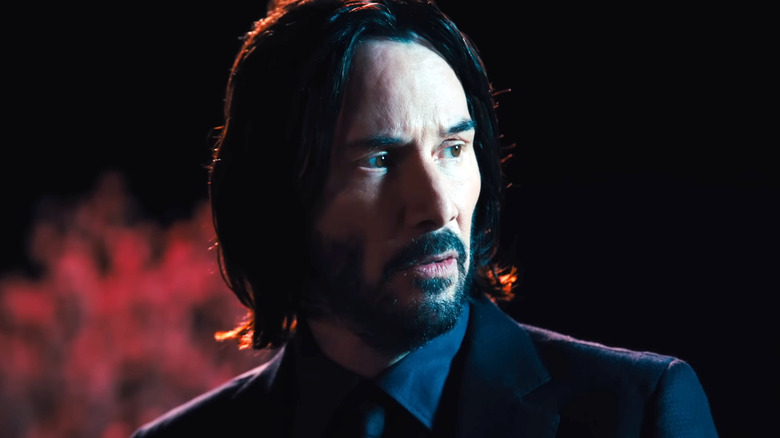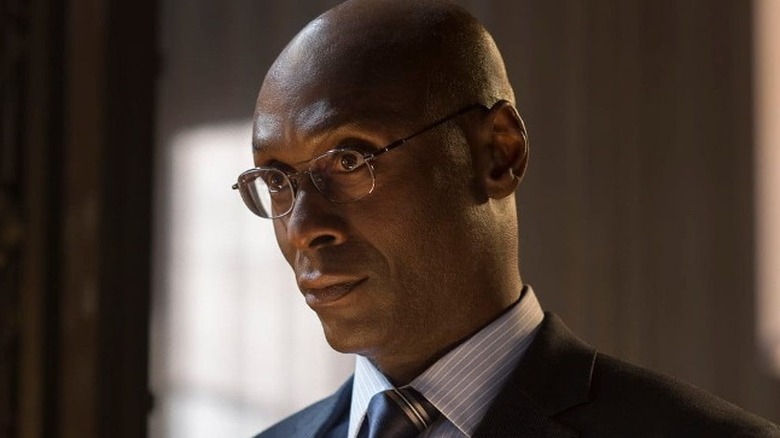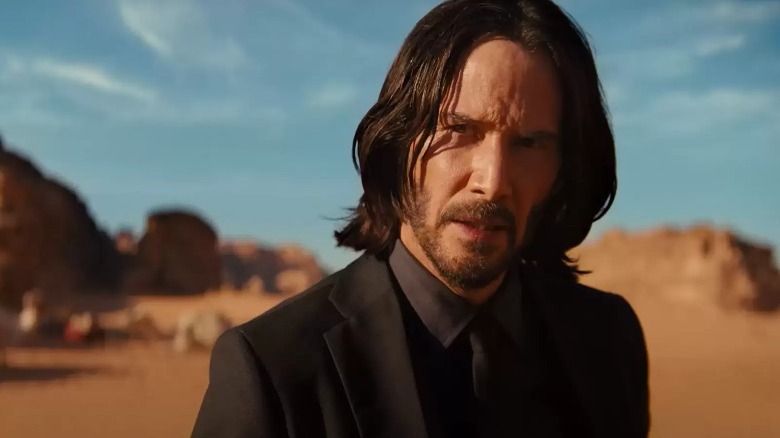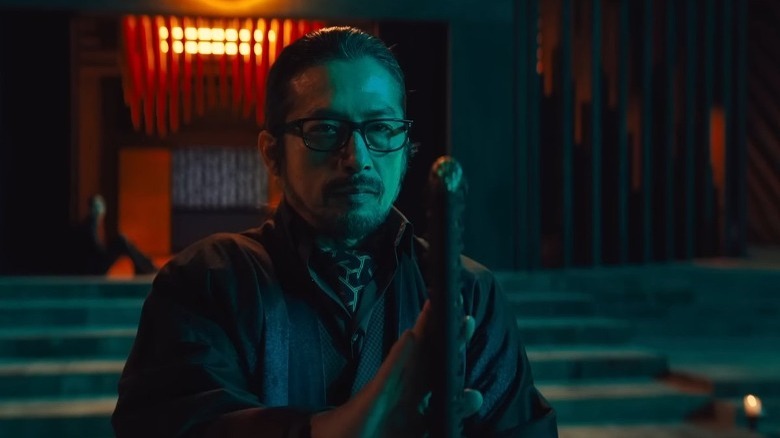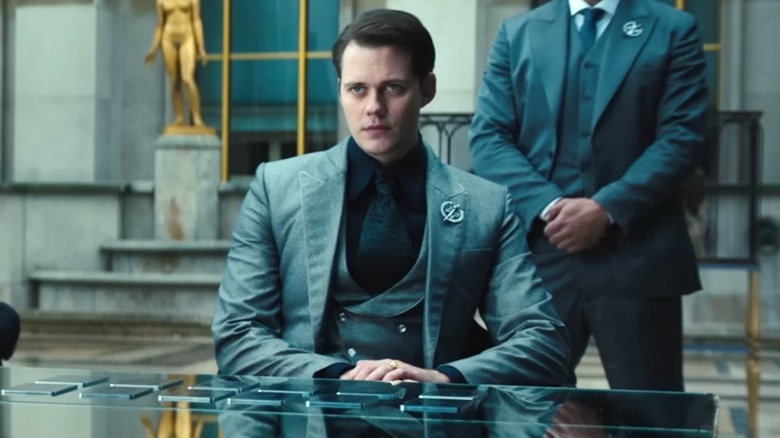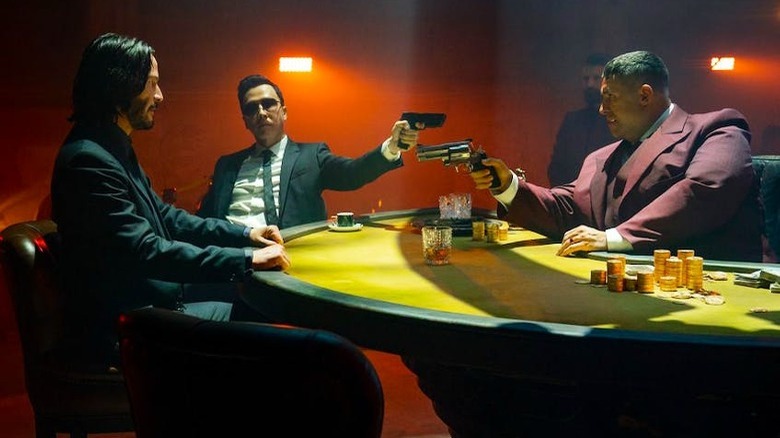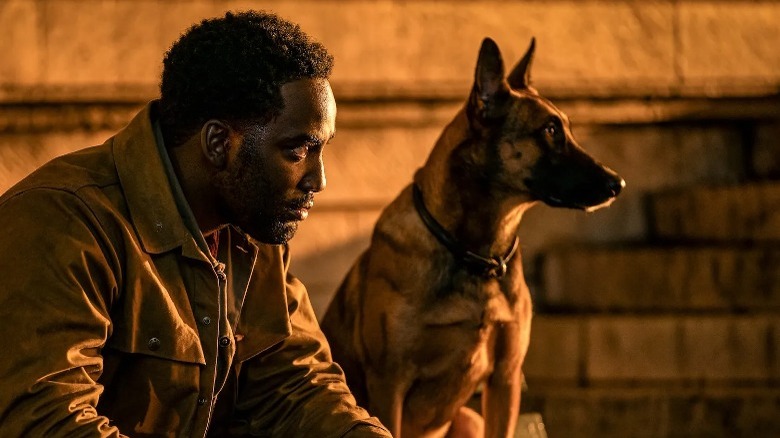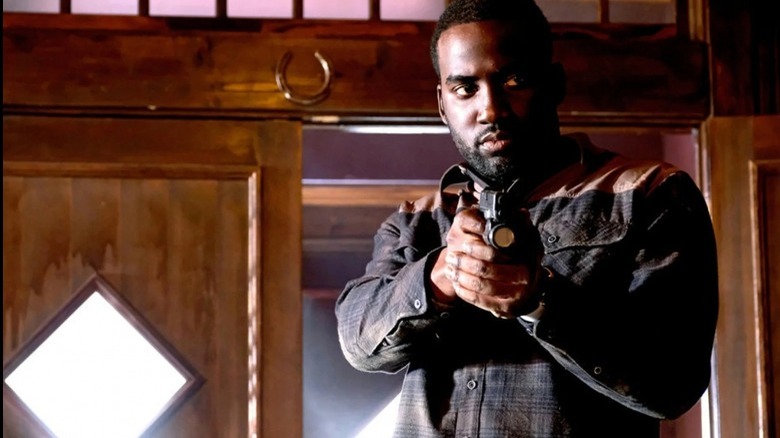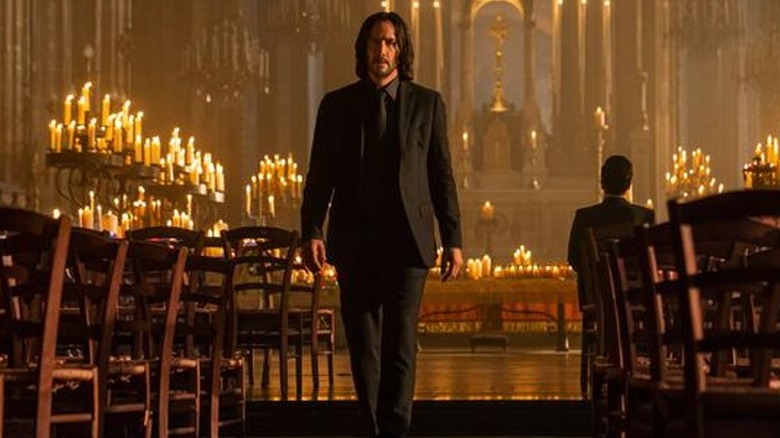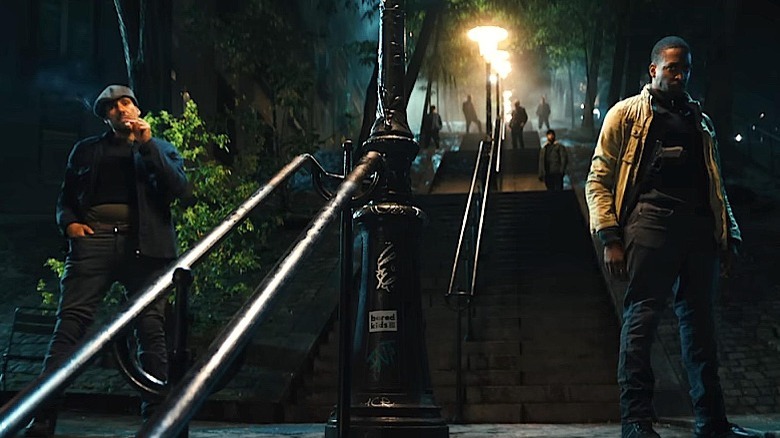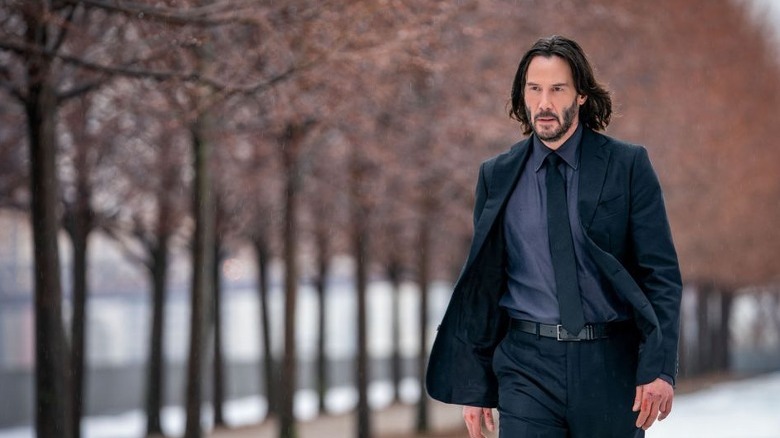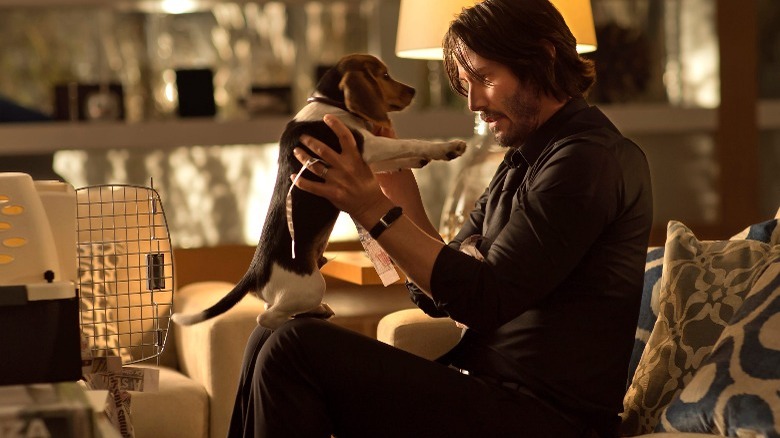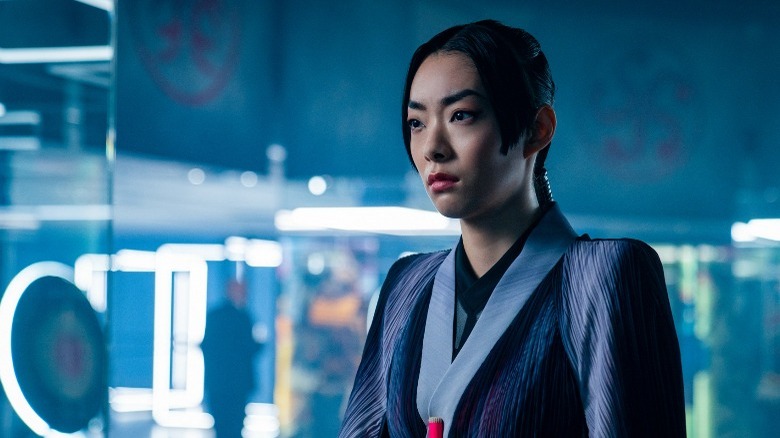John Wick 4 Moments That Really Upset Fans The Most
Contains spoilers for "John Wick: Chapter 4"
"John Wick: Chapter 4" is a vivid display of what makes this pulse-pounding saga great. Keanu Reeves is a big part of this success: His amiably unflappable calm, which endures through every reality-melting twist these movies hurl at him, is irresistible. He's like a stoic mascot for the concept of suspending your disbelief – at times, it almost feels like he's also watching the movie he's starring in as it unfolds. And boy, does this movie throw a whole lot at him. Fans and critics alike are eating it up: The fourth installment in this high-octane franchise has earned absolutely glowing reviews and some seriously impressive box office returns.
But "John Wick: Chapter 4" is not a perfect movie. The series' careful balance of seriousness and irony isn't always where it should be. Action scenes strung together by the vague connective tissue of plot threads often feel a bit unmoored. The pace isn't quite enough to sustain a true adrenaline rush — especially given the movie's immense length. Some fans are outraged by these flaws, while others are merely annoyed — but all of them have cause to complain. From Charon's fate to the movie's shocking ending, these are the moments from "John Wick: Chapter 4" that upset fans the most.
Charon gets shot
"John Wick: Chapter 4" ups its stakes early on by killing off a fan-favorite recurring character: Charon (Lance Reddick), the cool, collected concierge of the New York Continental. What makes it even more shocking is that he's coldly executed in retaliation for things that are entirely outside of his control. He essentially dies to make sure we understand our new villain, the Marquis Vincent de Gramont (Bill Skarsgård) — simply known as the Marquis, to his friends — is a really bad dude. After years of faithful service in the name of the High Table and its arcane rules, Charon goes out as collateral damage — and it's all because Winston (Ian McShane) doesn't hit John Wick with a fatal shot at the end of the last movie. It's harsh, to say the least.
This death hits especially hard, as "John Wick: Chapter 4" landed in theaters right on the heels of Lance Reddick's sudden death at the age of 60. This adds an unfortunate "too soon" cloud over the story beat. As with many of Reddick's best roles, the actor brings a calm and clear-eyed gravitas to Charon that cements the Continental as an authoritative edifice of power and meaning. He also plays fantastically off the expressive, wry tones of Ian McShane's performance. It's a tremendous shame that "John Wick: Chapter 4" will be his last appearance as the character: Reddick had been set to reprise the role in the franchise's "Ballerina" spin-off movie.
The half-hour of set up before the action starts
The last two sequels to "John Wick" basically start in media res. If you're not familiar, this is pretty much film nerd speak for "mid fight scene"; these action-packed features pick up the moment the prior movies leave off. "John Wick: Chapter 4," by contrast, starts remarkably slowly. Sure, a few people get shot and the New York Continental gets detonated, but it takes the movie a ponderous half-hour to set the table for the first big fight scene at the Osaka Continental. Relative to the quick pace that's made the franchise successful so far, this is a bold gamble for the fourth movie to take.
It's bolder still because it requires the audience to have a better-than-cursory recall of the "John Wick" timeline thus far. As some fans have pointed out, it's actually kind of hard to recall the details of the Wick-verse's archaic plot mechanics, even for devoted fans. The first three movies primarily focus on a multi-sensory barrage of fight scenes that just don't leave much RAM in your mind to keep the markers, tattoos, clans, odd bits of Latin, and everything else straight. And, despite how long it takes to get going, "John Wick: Chapter 4" doesn't work too hard to explain what's going on. Some viewers might have to Google who the dude in the desert John kills in the beginning even is (he's the "Elder" that sits above the High Table) to understand what's at stake.
Koji's unnecessary death
In some fans' minds, the "John Wick" movies are starting to resemble the crowd-pleasing "Fast and Furious" franchise in one key way: Each installment is fleshed out by actors whose vivid personalities make their roles instantly memorable, even when they have little time between fight scenes to actually distinguish themselves as distinct characters. In "John Wick: Chapter 4," Wick gains various new allies and frenemies, including Mr. Nobody (Shamier Anderson), Caine (Donnie Yen), Akira (Rina Sawayama), and Akira's father, Koji (Hiroyuki Sanada). They all manage to make a major impression, despite the fact that they duke it out with Winston and the Bowery King (Laurence Fishburne) for screen time. But you can't help but wish they had a little more room to breathe.
One especially frustrating moment arrives when the honorable Koji dies at Caine's hand, just after we meet him. The two square off in a completely meaningless show of pride, as Caine's real target, John Wick, has already fled the Osaka. Caine is even prepared to walk away at one point, but Koji makes a final, doomed lunge at him and forces his hand. The scene successfully drives home the moral weight of the death and calamity John Wick brings wherever he goes, but it also plays like a cruel and even somewhat flagrant twist of the knife.
The grisly hand scene
The "John Wick" franchise explores many ways villains can muster a tough and imposing appearance. "John Wick: Chapter 4" takes a different path with the Marquis, its main antagonist: He's a frightening adversary because of what he represents. Just like John Wick himself, the High Table — of which the Marquis is a senior member — is more of an idea that can't be killed than an actual group of mortal people. The Marquis cements this by acting as the sadistic personification of ancient, venal forces like greed and power, which sprout new heads like the mythical Hydra. "John Wick: Chapter 4" finds a particularly brutal way to let us know the Marquis is more twisted than usual: The vicious villain subjects Mr. Nobody to a horrific test of will.
Stabbing the bounty hunter through the hand, the Marquis essentially demands that he pull his hand out through the knife's blade instead of pulling the blade upwards. Mr. Nobody, apparently willing to do anything for a shot at the John Wick contract, complies in a squeamish bit of realistic effects work. Though it's a moment that fits perfectly with the over-the-top "John Wick" ethos, it's more visceral and intense than the franchise's normal fists-and-guns melees, prompting at least a few groans of surprise and disguist in theaters.
The confusing poker game
In general, the "John Wick" movies rely more on the poetry of their action sequences than the dramatic tension of the plot. This approach shows the most strain in "John Wick: Chapter 4," which really slows down between action set pieces to give us time to think. What this means is that audience members are a lot more likely to think, "Wait, what's going on here?" For example, Caine and Mr. Nobody follow John Wick around the entire movie. They're sort of trying to kill him, but they always manage to let him go. At no point is this more confusing than when they interrupt his face-off with Killa Harkan (Scott Adkins), a ruthless crime lord who killed his former mentor.
It's unclear why either mercenary is waiting so long to kill John Wick, or why John himself is acting so coy about attacking Killa. In truth, the whole scene really just seems like a thin excuse for him to end up with the famous "dead man's hand" of aces and eights during a poker game. It also contains one of the most confusing Caine-related moments: Despite being blind, he can tell exactly what his hand is. "Star Wars" fans might enjoy this unintentional callback to "Rogue One," where actor Donnie Yen also plays a blind character who can still sort of see, but everyone else is a little lost.
You hit my puppy
Perhaps in tacit acknowledgement that the audience might be getting somewhat desensitized to human-on-human violence after four full movies of it, "John Wick: Chapter 4" throws a very different sort of heart-skipping moment, late in its runtime. It goes back to the first movie's potent well by placing a dog in jeopardy — although this time, it's a thankfully brief moment of canine peril.
Mr. Nobody's faithful Belgian Malinois companion (whose name we sadly never learn) has more than won us over by the time he gets rudely tossed into a windshield by the Marquis' top henchman, Chidi (Marko Zaror). Despite the fact that he all but shatters the glass and bounces into the street, the dog gets right back up and barks to let us know he's okay. It's a sudden shock delivered during an otherwise surreally choreographed scene set beside Paris' Arc de Triomphe, and it hits hard. Some fans, perhaps still scarred from the first movie, have even taken to platforms like Reddit to make sure the dog lives before they actually see the movie.
Mr. Nobody's Powerball logic
As the saying goes, money makes the world go 'round. But it's apparently even more desirable in the "John Wick" universe — exponentially so, in fact. How do we know this? By the fact that as the bounty on John Wick grows, hundreds upon hundreds of people decide that the price is suddenly right to take him on themselves, even though the previous thousand-odd attempts on the life of "Baba Yaga" have failed. But there are exceptions to this rule. For most of "John Wick: Chapter 4," it seems like Mr. Nobody is the rare character to realize this. He seems content to simply track John from place to place and try to bilk the Marquis for a finder's fee.
But late in the game, we learn that even Mr. Nobody has a price: $40 million dollars. When the Marquis agrees to it in desperation, Mr. Nobody finally goes all-out in an effort to bag John. This happens after he gets the drop on the unkillable protagonist multiple times — but then, the bounty is in the paltry $20-26 million range. Mr. Nobody loses a fair amount of intrigue when we realize that he's just like people who only play the lottery when it gets over $1 billion, because hundreds of millions just can't get them out of bed. When he changes his mind again after John saves his dog's life, it endears him to us — but it doesn't make his character any more coherent.
The moment you had to use the bathroom
Even before "John Wick: Chapter 4" came out, fans pointed out that its 169 minute runtime is seriously lengthy. This is a serious departure: The first three movies in the series endeared themselves to fans, in part, by being sprints instead of marathons. Even the biggest "John Wick" fans might feel like the fourth installment either needs to be shorter, or that it should have an intermission to allow us to stretch our legs.
It doesn't help that this feels like part of a pernicious trend in modern cinema. Everything, from indie darlings like "Everything Everywhere All At Once" to blockbuster fare like "The Batman," seems to be pushing three hours these days, and the "John Wick" formula doesn't lend itself as well to a bloated runtime as other franchises do. The length really puts a strain on the scenes between action sequences, which mostly consist of characters explaining made-up High Table rules that are hard to follow. And that's not even getting into what this length asks of audience's bladders.
The endless staircase
After an epic battle that sees him go through seemingly every gun-owner and thug-for-hire in Paris, John Wick finally reaches the Sacré-Cœur Basilica just before dawn. He's there for his duel with the Marquis, but he finds himself at the bottom of a long staircase populated by dozens more goons to fight. And so he does — but maddeningly, he falls back down several flights at multiple points. The fact that this moment arrives just as "John Wick: Chapter 4" is pushing past the two-and-a-half-hour mark really tries our patience.
This is also the last real action sequence of the movie, which makes its dim lighting and monotonous fights all the more frustrating. This is a mostly repetitive battle sequence, full of tumbling and grunting and getting back up again. It's mildly affecting when Caine arrives to help John Wick to the top, but even the final climb feels like it takes way longer than the two or three pre-sunrise minutes John claims he has left. It's hard not to feel a little impatient, even if you've previously loved watching John Wick take people down.
John Wick dies?!
Hold on: John Wick dies at the end? The same John Wick we've watched kill thousands of people in a few days over the course of the first three movies? The same John Wick who easily survived getting hit by four cars and falling down 500 concrete steps? The unconquerable, merciless Baba Yaga, whose name is in the title of every movie? Our protagonist's death in the potentially final chapter of the main franchise has fans shocked and divided. Some feel like it undermines the whole story, while others are hoping it's a total fake-out.
After so much violence and death, it really does feel like John Wick's defining character trait is surviving in spite of impossible odds. In a way, he exists more as a force of nature than a corporeal man. It's mildly satisfying that his actions help Caine become free of the High Table and allow Winston to get the Continental restored — but for John, the outcome is no different than if he'd died at any of the hundreds of earlier points in the saga when someone has tried to kill him. With no one left to avenge, there's a strange and potent kind of beauty in John Wick surviving for his own sake. His apparent death, in contrast, seems to support the Marquis' more nihilistic view. He sees John as essentially defined by death, and according to this movie, that may be true — and the final word on the matter.
John doesn't see his dog as he's dying
"John Wick: Chapter 4" attempts to come full circle as John sits dying on the steps of the Sacré-Cœur. His life flashes before his eyes, and we see him with his wife as he lingers on their brief and lovely marriage. But, as some fans have been quick to point out, Daisy, the adorable beagle his wife left him after her death — the dog whose murder draws him back into the assassin world in the first place — is nowhere to be seen.
Now, we mean no offense to the memory of Helen Wick (Bridget Moynahan). John loved her immensely. But Daisy deserves to be in the montage as well. John cared so much for her, he kicked off an entire cinematic saga in response to her untimely demise. Seeing her fail to appear in the montage is kind of like watching the Oscars snub people by leaving them out of the "in memoriam" segment. In fact, it's almost more annoying: "John Wick: Chapter 4" only has two deaths to keep track of.
There was a post-credits scene?
"John Wick: Chapter 4" is the first film in the "John Wick" franchise to feature an after-credits scene, much to the consternation of many fans who, not expecting one, left the theater early. It's disappointing, from a certain angle, to see a movie franchise once confident enough in its own appeal to eschew such ending teases of future events suddenly bow to the trend that Marvel movies have made feel obligatory. It's also kind of a big ask to make of an audience that just sat through the longest "John Wick" movie yet.
Moreover, the fans who do make it all the way might be disappointed, as the scene itself is maddeningly brief. Akira, unsurprisingly, has tracked Caine down to avenge her father's death. In a public square, she approaches a seemingly oblivious Caine and whips out a knife — but the screen cuts to black, leaving both of their fates unknown. This is frustrating enough on its own, but "John Wick: Chapter 4" also disappoints grief-stricken fans who might have hoped that a post-credits scene would hint that John Wick isn't really dead after all.
